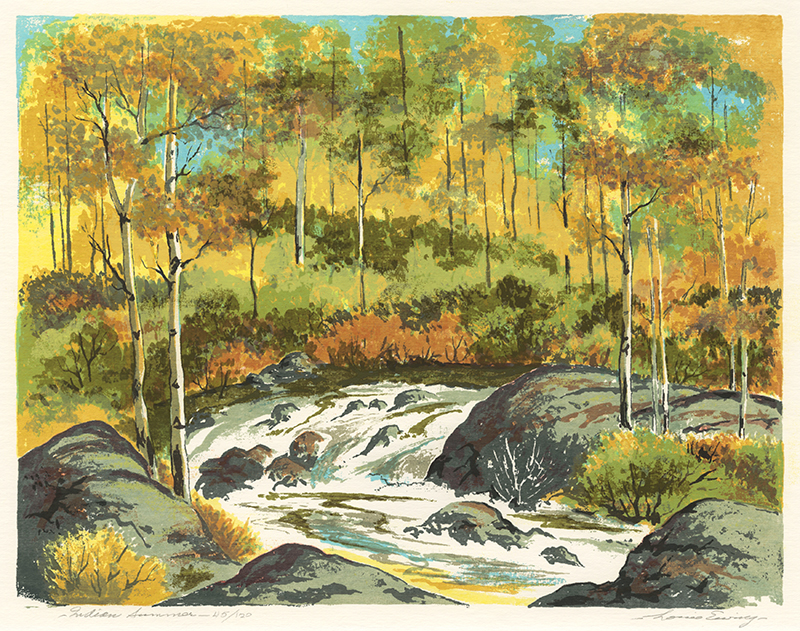Indian Summer is a color serigraph created about 1950 by American artist Louie Ewing. It is pencil signed, titled and editioned 45/120. It was printed by artist on a sturdy off-white wove paper and the image measures 11-5/16 x 14-7/16 inches.
This autumnal scene is illuminated by the golden leaves of white barked Aspens. It is early in the season as leaves still cling to the branches and the white water of the rushing stream suggests the summer monsoon season brought much relief to the parched landscape. This serigraph is quite painterly with transparent washes of ink while the dark passages remind one of calligraphic strokes.
Louie Ewing, painter, printmaker, designer, and illustrator, was born on 22 December 1908 in Pocatello, Idaho. After high school he attended Gooding College and Idaho State but neither institution had an arts program. At the suggestion of a former teacher, Ewing moved west in 1933 to Santa Maria, California to attend the Santa Maria Junior College (now the Allan Hancock College) where Stanley Breneiser headed the art department.
In 1935, Ewing followed Breneiser to Santa Fe, New Mexico where they taught at the newly organized Eidolon Art School, which unfortunately closed after one year. Ewing married Marrie Breneiser and the couple decided to remain in Santa Fe.
At first, Ewing taught art in a private elementary school and fulfilled commissions in the commercial art field. In the midst of the Great Depression, he joined the WPA Federal Art Project working under Russell Vernon Hunter. In the late 1930s the Washington, D.C. headquarters of the Federal Art Project sent Hunter materials on the process of silkscreen printing with encouragement to spread the knowledge of the technique in the Southwest. Hunter selected Louie Ewing as the person to master the technique and teach it to others. He headed the WPA printmaking workshop in Santa Fe and, in a short time, he set up a shop for silkscreen printing and began producing prints.
Louie Ewing is one of the first artists in the United States to “work creatively with serigraphy” as original prints, and for posters and book illustrations. In the late 1930s, Kenneth Chapman, curator of the Laboratory of Anthropology in Santa Fe, collaborated with Russell Vernon Hunter in a WPA project to create a portfolio of Navajo Blankets spanning the years 1840 to 1910. Chapman selected the weavings from the Laboratory’s collection and Ewing reproduced the designs using serigraphy. The fifteen silkscreens were each printed 200 times and the resulting portfolios were distributed to libraries, universities and museums. For thirty-three years, Ewing produced the posters for the Intertribal Indian Ceremonials held at Gallup, New Mexico.
In the late 1940s Ewing taught at the Indian School in Santa Fe and trained a number of Native Americans in the silkscreen technique. In 1951, artists Harrison Begay, Charles Barrow, and A. Hamilton Mencher founded the Tewa Enterprises print shop in Santa Fe where artists Woody Crumbo, Harrison Begay and Gerald Nailor printed their serigraphs. Many Anglo artists also took up the technique, including many from Texas, Colorado, and Oklahoma who were exposed to silkscreening while visiting Santa Fe.
Ewing was also a landscape painter in watercolor, gouache, and oil, and he also worked in stained glass, tile, and sculpture. He was hired by the Laboratory of Anthropology to paint explanatory and decorative panels for their exhibitions, and he created silkscreen illustrations for books.
Ewing did not seek to acquire fame in the art world and his exhibitions were almost always confined to New Mexico. His work is represented in the permanent collections of the Albuquerque Museum, New Mexico; the New Mexico Museum of Art, Santa Fe; the Harwood Museum of Art, Taos, New Mexico; the Gilcrease Museum, Tulsa, Oklahoma; and the Georgetown University Art Collection and the National Gallery of Art, Washington, D.C.
Louie Ewing died in Santa Fe on 1 December 1983.



